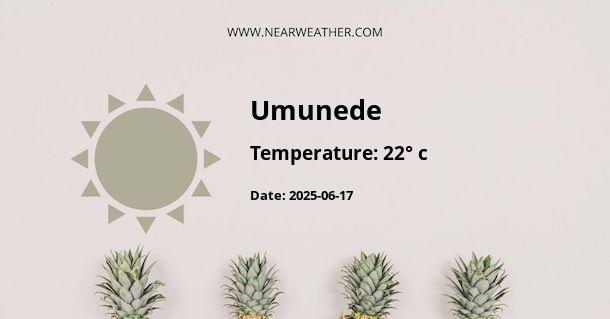Climate and Weather in Umunede, Nigeria
Located in the Delta State of Nigeria, Umunede experiences a tropical savanna climate characterized by distinct wet and dry seasons. The climate in Umunede is influenced by its proximity to the equator, as well as the surrounding topography and the movement of the West African monsoon system.
Temperature
The temperature in Umunede remains relatively consistent throughout the year, with average highs ranging from 30°C (86°F) to 35°C (95°F) and average lows ranging from 20°C (68°F) to 25°C (77°F). The hottest months are typically February and March, while the coolest months are July and August.
During the dry season, which lasts from November to April, temperatures can occasionally soar above 40°C (104°F) during heatwaves. This period is characterized by clear skies, low humidity, and warm temperatures. In contrast, the wet season, which lasts from May to October, brings cooler temperatures due to increased cloud cover and rainfall.
It is important to note that Umunede, like many other places in Nigeria, experiences a high level of humidity throughout the year. Humidity levels can reach up to 90%, especially during the wet season, making the weather feel hotter and more uncomfortable.
Rainfall
Umunede receives the majority of its annual precipitation during the wet season, with rainfall amounts ranging from 1200mm to 2000mm per year. The peak of the rainy season occurs between June and September, with August being the wettest month. During this time, heavy downpours and thunderstorms are common, often resulting in localized flooding.
The dry season, on the other hand, experiences significantly less rainfall, with the months of December and January being particularly dry. Some light showers may still occur during this period, but they are infrequent and do not contribute significantly to the overall rainfall total.
It is worth noting that climate patterns can vary from year to year due to factors such as El Niño and La Niña events. These climate phenomena can influence rainfall patterns and temperature fluctuations, leading to deviations from the typical climate norms.
Wind Patterns
Umunede experiences a change in wind patterns between the wet and dry seasons. During the dry season, the prevailing winds blow from the northeast, originating from the Sahara Desert. These dry and dusty Harmattan winds can bring haze and reduce visibility in the region.
In contrast, during the wet season, the prevailing winds shift to a southwesterly direction, bringing moisture-laden air from the Gulf of Guinea. These winds contribute to the formation of the West African monsoon system, which is responsible for the majority of the rainfall in the region.
Climate Hazards
While the climate in Umunede is generally favorable, there are some climate hazards that residents need to be aware of. The heavy rainfall during the wet season can lead to flooding, especially in low-lying areas. This can result in damage to infrastructure, crops, and homes, and can also pose a risk to human safety.
The high humidity levels combined with hot temperatures can also contribute to heat-related illnesses if proper precautions are not taken. It is essential to stay hydrated, seek shade, and avoid prolonged exposure to the sun during the hottest parts of the day.
Conclusion
Umunede experiences a tropical savanna climate with distinct wet and dry seasons. The temperature remains relatively consistent throughout the year, with the dry season being hotter than the wet season. The region receives the majority of its rainfall between June and September, with August being the wettest month. The prevailing winds change direction between the wet and dry seasons, and climate hazards such as flooding and heat-related illnesses should be taken into consideration.
A - Umunede's Latitude is 6.263740 & Longitude is 6.311610.
A - Weather in Umunede is 23° today.
A - Climate Conditions in Umunede shows overcast clouds today.
A - Humidity in Umunede is 96% today.
A - Wind speed in Umunede is 3.46 km/h, flowing at 275° wind direction. today.
